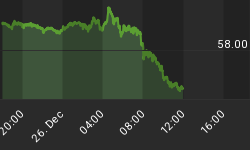In a span of 4 weeks, investors (as represented by the "dumb money" indicator) have gone from a state of despair to one of euphoria. In over 20 years of data, this is the shortest time it has ever taken the indicator to go from extremely bearish to extremely bullish. I am not sure what to make of this tidbit of information, but it does point out how silly and fickle investors have become. One minute they are bearish, and the next they are bullish. All this uncertainty what is an investor to do!
What is certain is that the "dumb money" is extremely bullish and the "smart money" as represented by corporate insiders is extremely bearish. In general, this is not a good mix for higher prices. The current data is consistent with market tops seen in March, 2010 (4 weeks prior to "flash crash"), February, 2011 (the start of a 6 month top), and March, 2012 (the Q2 top). The lone notable exception was November, 2010 when the market moved higher following the announcement and implementation of QE2 and the European LTRO. However, that was then and this is now, and investors have not received QE3 and QE4 warmly. One has to wonder if fatigue is finally setting in to all this money printing and can kicking.
In the short term and despite these serious sentiment headwinds, the market has found a floor. Holiday trading, hope for investment funds to magically flow into the market to start the New Year, and the hope and the expectation for a fiscal cliff resolution will keep the market going through the end of the month. But the rubber band wasn't stretched too far at the recent bottom. There aren't any bears to produce short covering. So things should not get too crazy on the upside. However far the rally goes and over the longer term, the rally will stall and it will likely be a part of what will eventually be recognized as a market top.
The "Dumb Money" indicator (see figure 1) looks for extremes in the data from 4 different groups of investors who historically have been wrong on the market: 1) Investors Intelligence; 2) MarketVane; 3) American Association of Individual Investors; and 4) the put call ratio. This indicator is bullish. A bear signal is confirmed when the indicator crosses back below the upper trading band.
Figure 1. "Dumb Money"/ weekly
Figure 2 is a weekly chart of the SP500 with the InsiderScore "entire market" value in the lower panel. From the InsiderScore weekly report: "Our market-wide sentiment reading continues to be within the Strong Sell Bias zone. Some of the selling may be a reaction to the possibility of higher capital gains tax rates going into effect next year, particularly sales by 10% Owners, which are helping push outflow figures to extremes. The Consumer Discretionary, Consumer Staples and Industrial Goods sectors are the leading causes of negative sentiment, with strong assists from Healthcare and Technology. There continues to be a high volume of Cluster Sales and Sell Inflections, and, a low volume of actionable buying."
Figure 2. InsiderScore "Entire Market" value/ weekly
Figure 3 is a weekly chart of the SP500. The indicator in the lower panel measures all the assets in the Rydex bullish oriented equity funds divided by the sum of assets in the bullish oriented equity funds plus the assets in the bearish oriented equity funds. When the indicator is green, the value is low and there is fear in the market; this is where market bottoms are forged. When the indicator is red, there is complacency in the market. There are too many bulls and this is when market advances stall. Currently, the value of the indicator is 60.59%. Values less than 50% are associated with market bottoms. Values greater than 58% are associated with market tops. It should be noted that the market topped out in 2011 with this indicator between 70% and 72%.
Figure 3. Rydex Total Bull v. Total Bear/ weekly
TheTechnicalTake offers a FREE e-newsletter: HERE
Visit TheTechnicalTake website: HERE
















